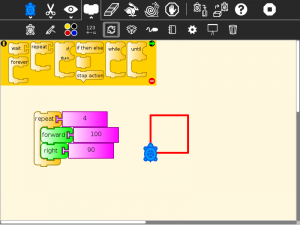Archive/Current Events/2012-08-03
Sugar Digest
1. I've spent much of the week working on Turtle Art. At the urging of Cynthia Solomon, I decided to make some visual changes to some of the blocks, in an effort to make it a bit easier to follow program flow. To that end, I changed the way the flow block works. For example, the Repeat block had an overhang to the right below which you could stack blocks that would be repeated. Once the repeating was complete, flow continued on to blocks attached to the bottom of the repeat block. I've often seen people confused by this: they have been uncertain where to attach the blocks to repeat and have had to use vertical-spacer blocks to make their programs less cluttered. In the new look, the Repeat block has a clamp (or jaws) that surround the blocks to repeat and it auto-expands, eliminating the need to use vertical-spacer blocks. In this case, a picture is worth a thousand words. In addition to Repeat, there are new blocks for Forever, If-then, If-then-else, While, Until, and, from the Extras palette, the Collapse block. The latter is useful for collapsing a large stack of blocks into a single brick.
2. Stephen Jacobs sent a pointer to the projects his students at RIT have done this year:
- Quilt is a chat system designed for mesh networks. It was written in Python and uses Zeromq as a way to pass data between nodes. Each node connects to other nodes and allows a user to chat. The end goal is to have a resilient chat network that auto discovers nodes on a mesh network.
- PyCaveExplorer is designed to teach children basic electronics by having them explore randomly generated, grid-based caves. The goal is to create a lit path from the starting tile to the goal tile by placing lights, batteries, and connecting pieces of wire. The base educational goal is to teach how simple circuits work, along with the differences between series and parallel circuits, and the relationship between a power source and the number of things connected to it.
- In Point-and-Click-Arthur, the player is Arthur's Royal Detective. The goal is retrieve all the knights who are in the middle of their most famous quests for a banquet at Camelot. The game is a "point and click" game in the same vein as Monkey Island and King's Quest. The user reads dialog, hunts for an item on screen, and figures out who to use the item on. This causes a reaction and new areas open, etc.
3. I had blogged about a meeting with Teemu Leinonen from Alto University last week and had mentioned that I was working on a new activity inspired by TeamUp. The beta version of Bulletin Board is ready for testing. It is quite simple: think of it as Portfolio shared among multiple users. Starred entries in your Journal are shared, along with an audio recording.
4. Danishka Navin reports from Sri Lanka that next month, another remote school will be running Sugar on Hanthana Linux.
5. Meanwhile, Sameer Verma has been having some adventures on the sub-continent.
6. Hilaire Fernandes of DrGeo fame shared a cool video of some of the things you can do. Worth checking out.
7. Daniel Narvaez announced that he has released a new sugar-build that should make it pretty easy to build Sugar on most GNU/Linux systems (tested on the latest Fedora and Ubuntu systems).
git clone git://git.sugarlabs.org/sugar-build/sugar-build.git cd sugar-build make build make run
Don't forget to read the README file.
8. Last week Bert Freudenberg announced a release candidate for Etoys 5.0.1. Please help with testing.
9. Reuben Caron announced the final release of OLPC OS 11.3.1 for XO-1, XO-1.5 and as a formal release for XO-1.75. Details are available at [12].
10. Meanwhile, Daniel Drake announced another candidate release of 12.1.0. Please help test this build as well.
Sugar Labs
Visit our planet for more updates about Sugar and Sugar deployments.
